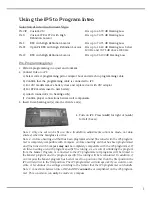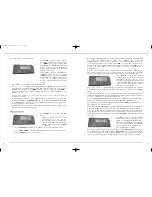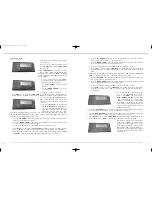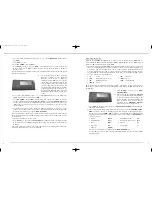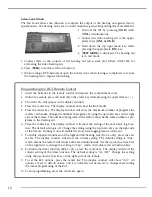
• Press the [
UP ARROW
] under the desired channel to increase the value. This will
increase gain for inputs above a conversational level.
• Press the [
DOWN ARROW
] under the desired channel to decrease the value. This will
decrease gain for inputs above conversational level.
• To choose another input level press [
INP
] in the mode window (see B).
• Press [
BACK
] (see B) to return to
FINE TUNE.
An exclamation point (!) will appear in
the mode window next to [
IG
] to indicate that a change has been made to Insertion
Gain.
c) Adjustments may be made for soft inputs (approximately 20-30 dB HL) in the [(
SOFT
)
INS
GAIN
] screen. Insertion gain values and target (TG) values are displayed.
• P ress the [
UP ARROW
] under the desired channel to increase the va l u e. This will incre a s e
gain for inputs below a conve rsational leve l .
• Press the [
DOWN ARROW
] under the desired channel to decrease the value. This will
decrease gain for inputs below a conversational level.
• To choose another input level press [
INP
] in the mode window (see B).
• Press [
BACK
] (see B) to return to
FINE TUNE.
An exclamation point (!) will appear
in the mode window next to [
IG
] to indicate that a change has been made to
insertion gain.
3. To access Maximum Power Output press
[
= =›
] in the
Fine Tune
mode (see B)
f o l l owed by [
M P O
]. The display re a d s
[
MPO (OUTPUT: dB HL)
]. Actual MPO
values are displayed above target (TG)
values for each frequency region. Ideally
these numbers should match in order to
achieve Inteo’s unique Loudness Mapping
criteria, however values may be adjusted
manually if necessary.
• Press the [
UP ARROW
] under the desired channel to increase MPO values.
This will
increase the MPO for all frequencies where output can be increased.
• Press the [
DOWN ARROW
] under the desired channel to decrease the MPO values.
This
will decrease the MPO for all frequencies where output can be decreased.
• Press [
BACK
] (see B) to return to
FINE TUNE.
An exclamation point (!) will appear in the
mode window next to [
MPO
] to indicate that a change has been made to MPO.
The default setting for Inteo is Automatic
Output Control [
AOC
]
on
. This prevents
distortion of high outputs. It is recom-
mended that AOC remain active unless the
client requires higher output from the hear-
ing aid even at its maximum gain settings.
Automatic Output Control may be turned
off
manually.
Fine Tuning Inteo
1. Turn on iP5: Press [
on R
] for right or [
on L
]
for left (See A).
Note: Only one ear can be fine tuned at a time.
2. Press [
MODE
] if iP5 is not in
FINE TUNE
mode (See B).
When in
FINE TUNE
m o d e you may access the
Loudness Master [
L N S
], Insertion Gain [
I G
] ,
Maximum Power Output [
M P O
] including
Automatic Output Control [
AO C
] and Occlusion
Manager [
O C C
].
1.
To access Loudness Master press [
LNS
]
(see B). The Loudness Master adjusts over-
all gain for all frequency regions.
• Use the [
UP ARROW
] to increase overall
loudness.
• Use the [
D OWN ARROW
] to decr ease
overall loudness.
• Changes are made in 1 dB steps.
Press [
BACK
](see B) to return to
FINE TUNE.
An exclamation point (!) will appear in the
mode window next to [
LNS
] to indicate that a change has been made to the Loudness Master.
2. To access Insertion Gain [
INS GAIN
] press
[
IG
] (see B). Insertion gain values can be
adjusted for each input level; normal, loud
and soft.
a) The first [
INS GAIN
] screen view reads
[(
Normal
)
INS GAIN
]. Insertion gain val-
ues for normal conversational inputs (50-
60dB HL) are displayed above the target
gain values for each frequency region.
The number displayed above the TG value is the actual insertion gain value. Ideally these
numbers should match in order to achieve Inteo’s unique Loudness Mapping criteria, however
values may be adjusted manually if necessary.
• Press the [
UP ARROW
] under the desired channel to increase the value. This will increase
gain for conversational level inputs.
• Press the [
DOWN ARROW
] under the desired channel to decrease the value. This will
decrease gain for conversational level inputs.
• To choose another input level press [
INP
] in the mode window (see B).
• Press [
BACK
] (see B) to return to
FINE TUNE.
An exclamation point (!) will appear in the
mode window next to [
IG
] to indicate that a change has been made to Insertion Gain.
b) Adjustments may be made for loud inputs (approximately 70-80 dB HL) in the [
(Loud)
INS GAIN
] screen. Insertion gain values and target (TG) values are displayed.
5
4
A
B
B
B
B
B
IN_IP5_Manual8.qxd 11/28/06 1:12 PM Page 4


